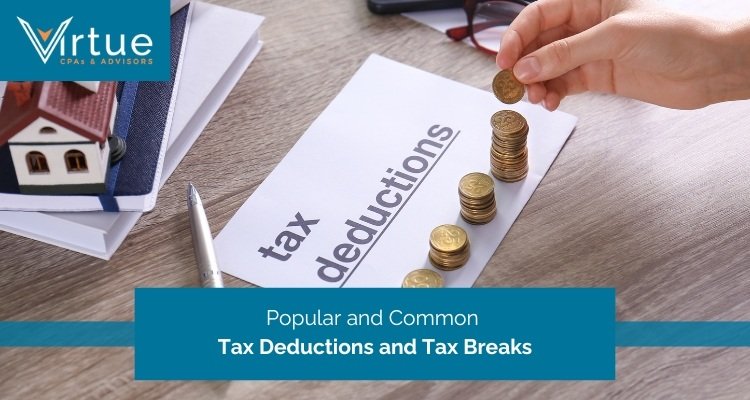Introduction
If you are looking for ways to reduce your tax liability, then hold on. Here are some tax breaks you should need to know about. In this blog, we will cover the most popular tax deductions and tax breaks that you shouldn't miss out on.
This is a complete guide on most commonly available tax deductions, tax credit, tax breaks to taxpayers by IRS. You may know some of them, you may have confusion around it and also may have some misconceptions about the tax deductions and tax breaks.
To help you, here is everything you need to know regarding IRS tax deductions and tax breaks. Let's get started!
Most Popular and Common Tax Deductions and Tax Breaks
However, the Tax Day was on April 15, 2024, for tax year 2023. If you have secured tax extension or filing your tax return, then here are some of the tax deductions 2024 that you can get benefit from them or avail these tax deductions for upcoming tax season 2025.
1. Child Tax Credit
The child tax credit (CTC) is a tax break that can be availed by you if you have children under 17. However, there are limitations of income to avail child tax credit.
For tax returns filed in 2024 of tax year 2023, you can receive up to $2000 for each child and $1600 of credit is possibly refundable.
2. Child and Dependent Care Credit
The child and dependent care credit (CDCC) helps pay for some costs of daycare and similar services for a child under 13, a spouse, a parent who needs care, or another dependent for allowing you to work.
Typically, you can get back a credit up to 35% of $3,000 for one dependent or $6,000 for two or more dependents.
3. American Opportunity Tax Credit
The American Opportunity Tax Credit (AOC) is tax credit you can avail all the amount of first $2000 spent on tuition, books, equipment and school fees. Even you can claim 25% of the next $2000 and can get a total of $2500 as a tax credit.
Here note that your transportation and living expenses will not be included.
4. Lifetime Learning Credit
The lifetime learning credit allows you to get back 20% of the first $10,000 spent on tuition and fees, up to a total of $2,000.
Like the American opportunity tax credit, this credit does not include living costs or travel as qualifying expenses, but you can include the cost of books or supplies required for your classes.
5. Student Loan Interest Deduction
Individuals can reduce their taxable income by up to $2,500 via the student loan interest deduction if they have paid interest on their student loans.
6. Adoption Credit
The adoption credit is a nonrefundable tax benefit that helps taxpayers cover some eligible costs of adopting a child.
However, after a certain income level, this adoption credit starts to reduce gradually and completely disappear once your modified adjusted gross income (MAGI) goes above the set limit of that tax year.
For instance, tax return filed in 2024 for the tax year 2023, the maximum credit amount is $15,950 and the credit starts to phase out when the MAGI hits $279,230 or more.
7. Earned Income Tax Credit
The Earned Income Tax Credit (EITC) is a tax benefit that gives money back to low-income taxpayers, whether they have children or not.
Tax return filed in 2024 for the tax year 2023, the credit amount varies from $600 to $7,430 based on the number of children, your marital status, and your income level.
8. Charity & Donation Deduction
You can also avail yourself of charity and donation deductions including cash gifts or physical items like clothes or cars. As stated by the IRS, you can deduct up to 60% of your adjusted gross income.
9. Medical Expenses Deduction
You can deduct qualified medical expenses that you pay out of pocket if they are more than 7.5% of your adjusted gross income for the tax year.
10. State and Local Taxes Deduction
You can reduce your taxes by using the State and Local Tax (SALT) deduction. The SALT deduction allows you to deduct up to $10,000 and $5,000 if you’re married and filing separately, with a combination of property taxes and sales taxes or state or local income taxes.
11. Mortgage Interest Tax Deduction
The mortgage interest tax deduction is promoted as a method to help make owning a home affordable. It lowers the federal income tax for eligible homeowners by decreasing their taxable income based on the mortgage interest they pay.
12. Gambling Loss Deduction
You can deduct the gambling losses and expenses if you have won the same amount compared to it. For instance, if you won the $200, you could report $200. However, you cannot deduct more than you win.
13. IRA Contributions Deduction
You can deduct contributions of your IRA (Individual Retirement Accounts) if you or your spouse have a retirement plan at work. It also depends on your income to avail yourself of the deduction.
14. 401(k) Contributions Deduction
You can deduct the money from your paycheck if contributed to traditional 401(k). However, there are limitations of the amount you can contribute.
For instance, in 2023 you can contribute $22,500 or $30,000 if you are 50 or older. Similarly, in 2024, the limit will be $23,000 or $30,500 for people aged 50 and above.
15. Saver’s Credit
The saver's credit is between 10% and 50% of the money you put into an IRA, 401(k), 403(b), or certain other retirement plans, with a limit of $2,000 ($4,000 for joint filers). Here, the credit you get depends on your income and the filing status.
16. HSA Contributions deduction
You can deduct Health Savings Account (HSA) contributions from your taxes, and you need not pay taxes on withdrawals for eligible medical expenses.
17. Self-Employment Expenses Deduction
Self-employed people, like freelancers and contractors, can take advantage of several valuable tax deductions on self-employment tax.
18. Home Office Deduction
The IRS allows you to deduct specific home office expenses like rent, utilities, property taxes, repairs, maintenance, and other related costs. If you regularly use part of your home solely for business purposes, you can take advantage of these deductions.
19. Educator Expenses Deduction
A teacher or qualified educator can deduct up to $300 for classroom materials. If you and your spouse, both are educators and file jointly, you can deduct up to $600 from your taxes.
20. Solar Tax Credit
You can avail yourself of the solar tax credit, residential clean energy credit up to 30% back on the installation costs of solar energy systems, such as solar water heaters and solar panels.
21. Energy Efficient Home Improvement Tax Credit
As updated in the Inflation Reduction Act, the energy-efficient home improvement tax credit offers a maximum of $3,200 in tax credits for eligible home improvements like energy-saving windows, doors, and heat pumps.
22. Energy Efficient Home Improvement Tax Credit
The Electric Vehicle tax credit for 2023 is between $3,750 to $7,500, and you can also avail $4,000 credit for buying used cars.
However, the eligibility for the credit depends on IRS standards of qualified electric vehicles and factors like income, the vehicle's price, etc.
What are tax credits?
Tax credits are the direct tax benefits you can get in your tax filing return. Tax credits are a sort of reward you get by IRS for your certain decisions such as raising or adopting a child, buying electronic vehicle, doing charity, etc.
Tax on these expenses can be calculated as tax credit and availed by the appropriate taxpayer. So, your tax amount will automatically be reduced with these tax credits. Thus, tax credit can reduce the tax amount you owe to pay.
There are three types of tax credits: !
1. Nonrefundable Tax Credit
Nonrefundable tax credits are amounts deducted from a person's tax bill until the tax owed reaches zero. If the credit is more than the tax due, the extra amount is not refunded and becomes a nonrefundable tax credit.
This means that any unused part of the credit is lost. These credits are valid only for the year they are claimed and cannot be carried over to future years.
2. Refundable Tax Credit
Refundable tax credits are the best type of credit because they can be fully refunded. This means that taxpayers can receive the entire credit amount, even if they owe no taxes, regardless of their income or tax situation. If a refundable tax credit reduces a tax bill to below $0, the taxpayer will get a refund for that amount.
One popular refundable tax credit is the Earned Income Tax Credit (EITC). It is designed for low to moderate-income taxpayers who meet certain criteria based on their income and family size, and who earn money through employment or self-employment.
Another refundable option is the premium tax credit. This credit helps individuals and families pay for health insurance premiums purchased through the health insurance marketplace.
3. Partially Refundable Tax Credit
Some tax credits are only partially refundable such as the American Opportunity Tax Credit (AOTC) for students in postsecondary education. In which you get the tax credit of the lesser of 40% of your tax liability or $1000.
What are tax deductions?
Tax deductions reduce your income that is subject to tax. Tax deductions allow you to decide your taxable income and that way you can indirectly reduce your tax bill.
As per the directions by IRS, you either avail standard deductions or itemized deductions. The difference between the two is the deduction amount.
Standard deductions are set in the fixed amount of tax deduction by IRS every tax year. In contrast, itemized deductions are selected by taxpayers manually depending on their income, filing status, and other regulations of IRS.
Above-the-line deductions and Below-the-line deduction
In Form 1040, there are two types of tax deductions: Above-the-tax-deductions and Below-the-line-tax-deductions.
Basically, tax deductions which are above the adjusted gross income (AGI) line in Schedule 1 of Form 1040 are above-the-line-tax-deduction. These deductions can be availed by all taxpayers whether they are choosing standard deductions or itemize deductions.
Above-the-line deductions are more like ‘adjustments’ which are adjusted and calculated to get your adjusted gross income.
Below-the-line-tax-deductions are below the adjusted gross income (AGI) line in Schedule 1 of Form 1040. These tax deductions have two subparts, standard deduction and itemize deduction. Taxpayers can select only one of them to deduct their taxes.
How to claim tax deductions?
As we have discussed, you can either avail yourself of the standard deduction or itemize deductions.
The standard deduction reduces your adjusted gross income by a fixed amount without any conditions. This fixed amount is based on your filing status. For instance, single filers can deduct $14,600 from their taxable income in 2024 if they choose the standard deduction.
While itemized deductions allow you to lower your taxable income by claiming various tax deductions as per your eligibility. Itemized deductions include tax deductions you may qualify for. The more you can deduct, the less tax you will owe.
There are lots of itemized deductions available in your tax return. However, each itemized deduction requires specific qualification. For instance, donations to charity, mortgage interest, and medical expenses that you have paid out of pocket.
You can claim anyone from these deductions where you found a more deductible amount.
Bottom Line
Now you can choose which deduction to claim, which tax break to avail. If you are still confused, then contact us!
Virtue CPAs is the most trusted advisory, accounting, and taxation firm in Atlanta, USA providing the best tax services that are compliant with IRS regulations and have maximum tax benefits for taxpayers.
Get in touch with us today and get our expertise tax advice for all your tax-related queries.
FAQs
You can claim tax breaks such as child tax credit, child and dependent care credit, American opportunity tax credit, lifetime learning credit, student loan interest deduction, adoption credit, earned income tax credit, charitable donation deduction.
Tax write-off is a term used for tax deduction. However, it is neither used by IRS nor mentioned in the Internal Revenue Code.
A tax write-off reduces your taxable income, which lowers the amount of tax you owe. It enables individuals or businesses to deduct certain expenses from their total income before calculating taxes.
For instance, you can deduct expenses like medical expenses, donations, or mortgage interest, or as a business owner, you can write off expenses such as rent, utilities, or office supplies.
To qualify for a write-off, you need to record and report these expenses on your tax return, along with any necessary documents. It's also important to ensure that the deductions comply with tax laws.
Tax rebate is the informal term used when tax amount is reduced because of the updated tax laws.
When you pay more taxes than you owe for the year, you get a refund called a tax rebate. This happens when the total taxes paid through estimated payments, deductions, or other credits is greater than what you owe. In these cases, the IRS gives back the extra amount to you.






